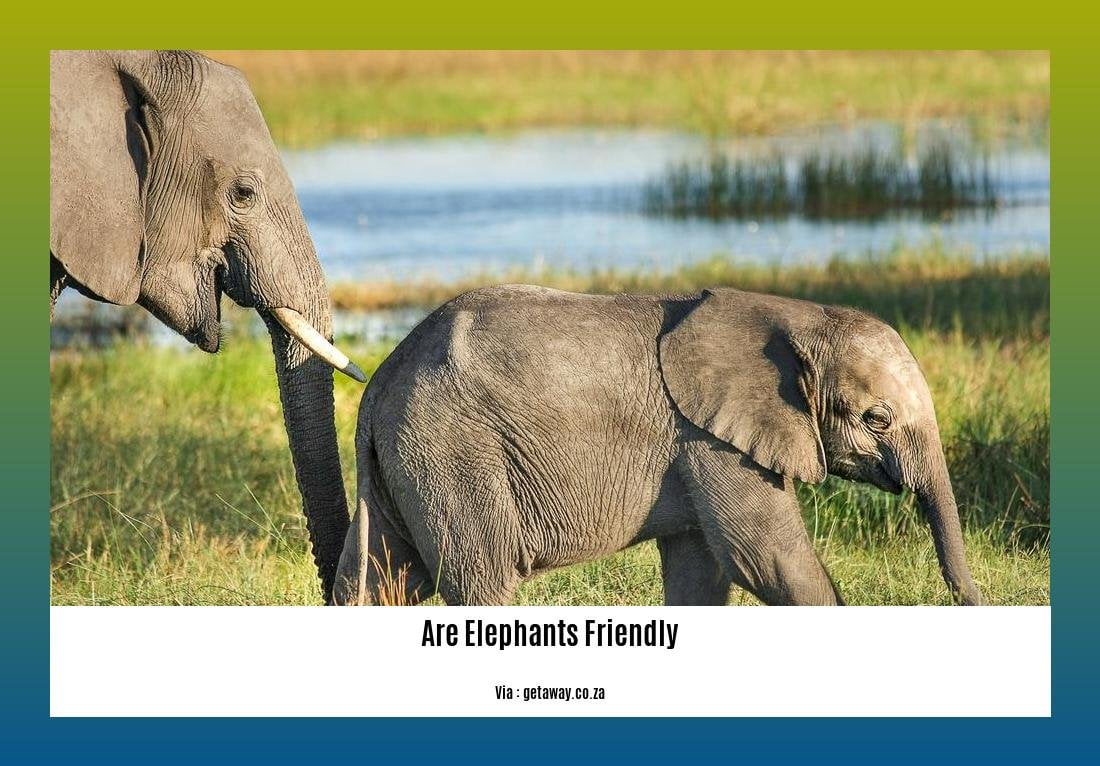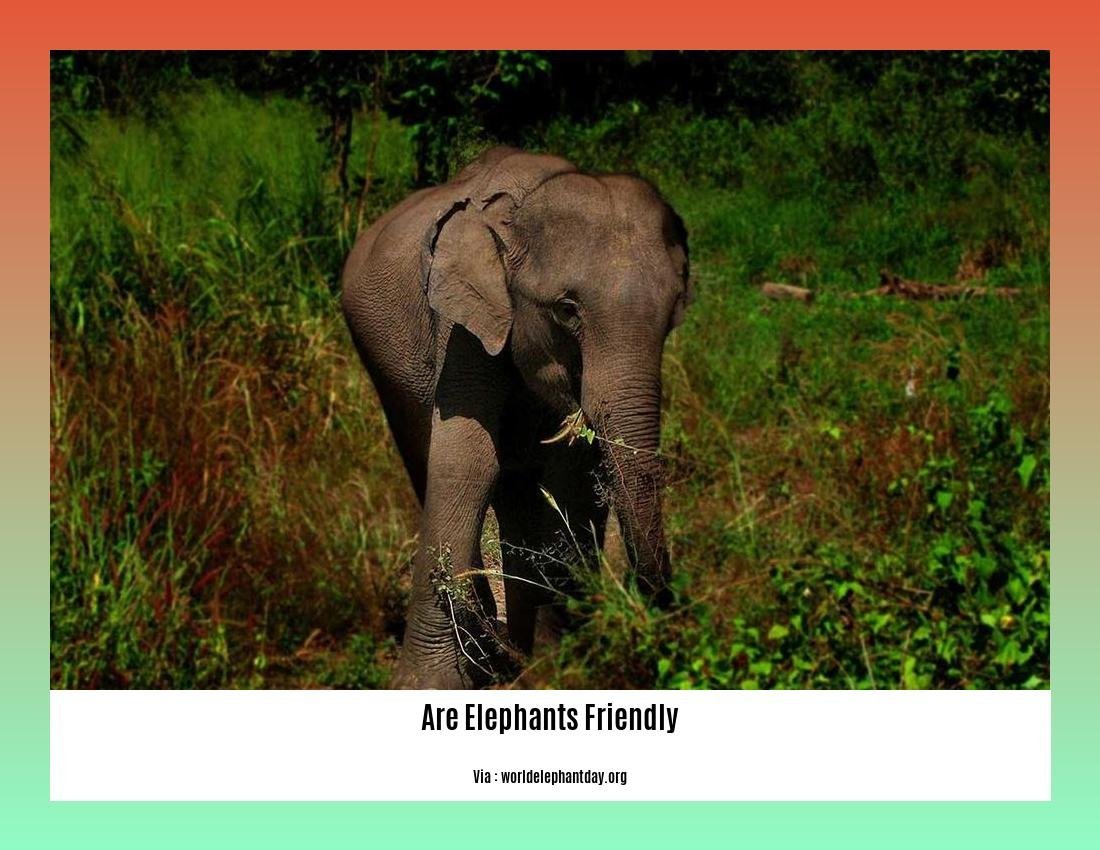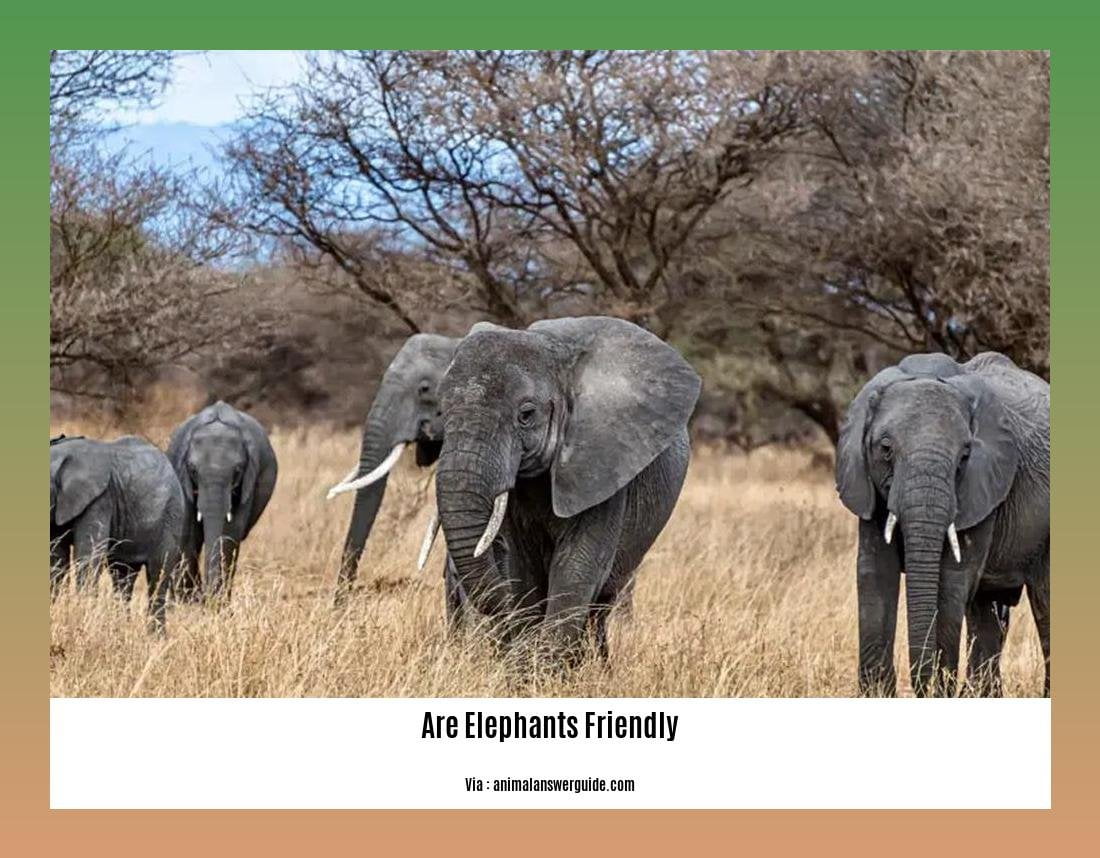Unraveling the Truth: Are Elephants Friendly by Nature? Elephants, the magnificent giants of the animal kingdom, have long fascinated both scientists and wildlife enthusiasts. But amidst their grandeur, one question lingers in the minds of many: Are elephants truly friendly creatures? In this article, we will delve into the depths of their social dynamics and behavior to unravel the truth behind their renowned friendliness. Through a carefully woven tapestry of scientific research and captivating storytelling, we will shed light on the gentle demeanor and remarkable emotional intelligence that make these majestic beings so fascinating.
Key Takeaways:
- Elephants are known to be friendly toward other elephants, living in family groups and forming lifelong friendships.
- They exhibit friendly behaviors, such as showing concern for injured or sick herd members and playing with each other.
- However, elephants are not naturally friendly toward humans and are considered to be disinterested in human well-being.
- Elephants can be trained to be friendly around humans in captivity, where they have frequent interactions with people.
- Elephants raised in captivity generally get along well with humans, but individual differences exist and the level of care provided is crucial.
- In summary, elephants are friendly within their own kind, forming strong bonds, but their friendliness does not extend to humans in their natural habitat.
Are Elephants Friendly by Nature?

When it comes to elephants, their nature and demeanor have always piqued the curiosity of wildlife enthusiasts and scientists alike. The question of whether elephants are friendly by nature is an intriguing one, as it delves into the social dynamics and behavior of these majestic creatures. Let’s dig deeper and unravel the truth behind their friendliness.
The Friendliness Within Elephant Herds
In their natural habitat, elephants exhibit remarkable social behaviors that highlight their friendly nature towards each other. These gentle giants often live in close-knit family groups, forming lifelong friendships within their herd. They engage in various friendly behaviors, such as showing concern and care for injured or sick individuals, displaying a level of emotional intelligence that is truly awe-inspiring.
Rhetorical Question: Have you ever wondered what it would be like to have a support system so strong that it spans an entire lifetime? Well, this is precisely what elephants have within their herds.
The Altruistic Side of Elephants
However, it is important to note that elephants are not inherently friendly towards humans in their natural environment. They are highly altruistic animals, but their altruism is primarily focused on their own kind. Their interest in the well-being of humans is typically minimal.
Rhetorical Question: Can we really blame them for not extending their friendly nature towards us? After all, we are intruders in their world.
Friendliness and Captivity
On the other hand, elephants raised in captivity can be trained to be friendly towards humans. In captive environments, where they have frequent interactions with people, elephants often learn to get along well with humans. However, it’s crucial to recognize that individual differences exist, and the level of care provided to these elephants plays a significant role in shaping their friendliness.
Analogical Statement: Just like humans, elephants are influenced by their surroundings and the experiences they encounter. While some may naturally be more affable, others may require time and patience to develop a friendly disposition.
The Verdict: Friendliness Depends on Context
To sum it up, elephants are indeed friendly creatures, but their friendliness is contextual. Within their own herds, they form strong bonds and exhibit behaviors that exemplify their amicability towards each other. However, this friendliness does not extend to humans in their natural habitat. Yet, through careful training and positive interactions in captivity, elephants can be more accommodating towards humans.
Rhetorical Question: Can we really blame them for being cautious around us? After all, elephants have faced numerous threats from human activities.
So, the next time you encounter an elephant, remember that their inherent friendliness is not directed towards humans. Instead, admire their social dynamics and lifelong bonds within their herds, acknowledging the beauty of their nature in its purest form.
Are Arctic foxes friendly? Find out more about Arctic foxes and their behavior towards humans by clicking here.
Are Arctic foxes friendly to humans? Discover whether these adorable creatures are safe to interact with by clicking here.
Are elephants friendly animals? Learn about the nature of elephants and their potential friendliness by clicking here.
Are elephants friendly to humans? Explore the fascinating relationship between elephants and humans by clicking here.
Exploring Instances of Human-Elephant Interactions: Positive and Negative
Human-elephant conflict (HEC) is a complex issue that poses significant challenges to conservation efforts and the well-being of local communities in areas where elephants reside. This conflict threatens the coexistence of humans and elephants and can have detrimental effects on both ecosystems and livelihoods. In this article, we will explore various instances of human-elephant interactions, both positive and negative, to gain a deeper understanding of this issue.
Understanding the Scope and Severity of HEC
HEC is an increasingly prevalent problem across elephant range areas worldwide. It is crucial to assess the impacts of HEC on both humans and elephants to develop effective mitigation strategies and promote sustainable cohabitation. The exclusion and destruction of elephant habitats are among the primary drivers of HEC. In many parts of Asia, including Indonesia, HEC poses a major threat to elephant populations.
Human Perceptions of Elephant Conservation and the HEC Connection
Understanding human perspectives on elephant conservation and its connection to HEC is vital for addressing this conflict and finding collaborative solutions that benefit both people and elephants. People’s perceptions of HEC significantly influence their attitudes towards elephant conservation. Negative interactions between humans and elephants, such as crop raiding and property damage, contribute to a negative perception of elephants.
Individual Differences in Elephant-Human Interactions
Research has shown that individual elephants exhibit variations in their interactions with humans, highlighting the complexity of HEC and the need for context-specific approaches to mitigation. Elephants may choose to initiate interactions with humans based on individual differences and preferences. Certain elephants have even shown a preference for interacting with specific individuals, indicating the existence of elephant-handler bonds.
Mitigation Strategies and Conservation Interventions
To reduce conflicts and promote coexistence, effective strategies and interventions are necessary to address the underlying causes of HEC and create harmonious environments for both humans and elephants. Mitigation methods for HEC should consider the role of local communities and their active participation in conservation efforts. Collaborative approaches involving community engagement, land-use planning, and early warning systems can help mitigate HEC.
Key Takeaways:
- Human-elephant conflict (HEC) poses a significant challenge to conservation efforts and the well-being of local communities.
- The exclusion and destruction of elephant habitats are primary drivers of HEC.
- Negative interactions between humans and elephants contribute to a negative perception of elephants.
- Individual elephants exhibit variations in their interactions with humans, highlighting the complexity of HEC.
- Mitigation strategies should consider the role of local communities and involve community engagement, land-use planning, and early warning systems.
References:
1. Nyumba, T. O., Emenye, O. E., & Leader-Williams, N. (2020). Assessing impacts of human-elephant conflict on human wellbeing and securing livelihoods in Africa and Asia. National Center for Biotechnology Information
2. Abdullah, A., Sayuti, A., Hasanuddin, H., Affan, M., & Wilson, G. (2019). People’s perceptions of elephant conservation and the human-elephant link. Springer
The Phenomenon of Elephant Empathy and Emotional Intelligence

Elephants have captivated researchers and nature enthusiasts alike with their exceptional display of empathy and emotional intelligence. These magnificent creatures exhibit behaviors that exemplify their deep connection and understanding of one another. Let’s delve into the fascinating world of elephant empathy and emotional intelligence to unravel the truth behind their extraordinary nature.
Empathy: A Core Trait of Elephant Society
Elephants are highly social animals that form strong bonds within their herds. One of the most striking aspects of their social dynamics is their ability to display empathy for their group members. In times of distress or danger, elephants have been observed protecting and comforting their fellow elephants. They go above and beyond to retrieve and babysit calves, assisting with moving and removing spears and veterinary darts attached to others. It is a testament to their deep sense of care and understanding for their herd mates.
Unprecedented Interest in Elephant Remains
Unlike any other species, elephants exhibit intense interest in the bones and ivory of deceased elephants. This behavior suggests a profound emotional connection and acknowledgment of the passing of their fellow herd members. It highlights the complexity of their emotional intelligence and their ability to comprehend the concept of mortality.
The Remarkable Intelligence of Elephants
Elephants are widely regarded as one of the most intelligent creatures on Earth. They possess an impressive capacity to learn and understand commands, which has facilitated their training for public shows and labor. Beyond their cognitive abilities, there are indications that elephants exhibit behaviors associated with self-awareness and the existence of “theory-of-mind.” These behaviors include empathy, mirror self-recognition, and sensitivity to the remains of deceased conspecifics. Elephants are capable of identifying animacy and goal directedness, grasping the physical competence, emotional state, and intentions of others even when they differ from their own.
The Role of Physical Touch in Elephant Empathy
Physical touch plays a significant role in elephants’ display of empathy. Similar to how touch provides comfort and support for humans in times of distress, elephants have been observed showing empathy towards their fellow elephants through physical touch. It reinforces their connection and provides solace in difficult situations, further emphasizing their highly empathetic nature.
Through an intricate blend of empathy, emotional intelligence, and social dynamics, elephants showcase their extraordinary ability to understand and care for one another. Their innate capacity for empathy sets them apart as one of the world’s most empathetic animals.
Key Takeaways:
- Elephants exhibit empathy by protecting and comforting their group members, retrieving and babysitting calves, and assisting with removing spears and veterinary darts.
- Their intense interest in the remains of deceased elephants showcases their emotional connection and understanding of mortality.
- Elephants are highly intelligent animals, displaying behaviors associated with self-awareness and theory-of-mind.
- Physical touch plays a significant role in their display of empathy, providing comfort and support for fellow elephants.
Citation:
1. The Conversation: “Elephants are sensitive and very social, but there is no evidence th…” Link
2. Lalibela Game Reserve: “Elephant empathy and their emotions – Lalibela Game …” Link
Unraveling the Truth: Are Elephants Friendly by Nature?
Human-elephant coexistence is a crucial aspect of conservation efforts that aims to address the challenges posed by elephant conservation and management while ensuring the peaceful coexistence of humans and elephants. As human populations continue to expand and encroach on elephant habitats, conflict between people and elephants has become a major concern for the survival of these majestic creatures.
Efforts towards human-elephant coexistence require a multi-faceted approach that involves balancing the integrity of conservation efforts with the needs and livelihoods of local communities. One key aspect is the importance of gaining local communities’ support for conservation and changing people’s attitudes towards elephant conservation. This can be achieved through further education, conservation awareness programs, and conflict mitigation measures.
Communities, particularly in Mali, have taken initiative and developed their own approaches to elephant and nature conservation. These approaches are based on their own values and include measures such as unarmed joint community/forester patrols. Empowering communities to participate actively in conservation efforts enhances their sense of ownership and promotes a more sustainable coexistence with elephants.
Conservation efforts for elephant protection involve various strategies, including researching and monitoring elephant populations, reducing habitat fragmentation, and establishing protected areas. It is essential to extend conservation efforts beyond protected areas and foster coexistence with agricultural communities. This recognizes the need to strike a balance between agricultural development and elephant conservation. By aligning conservation efforts with agricultural practices, it becomes possible to share resources with elephants wherever feasible, thus reducing conflict and promoting coexistence.
The perception of elephant conservation and the human-elephant bond plays a crucial role in achieving human-elephant coexistence. People’s perceptions influence their willingness to support conservation efforts and adopt practices that mitigate conflicts. It is vital to address the concerns and perspectives of local communities and involve them in decision-making processes related to elephant management. This can foster a sense of shared responsibility and encourage sustainable coexistence.
In conclusion, human-elephant coexistence is crucial for the long-term survival of elephants and the well-being of local communities. Efforts to achieve coexistence should prioritize gaining local support for conservation, empowering communities to develop their own approaches, extending conservation efforts beyond protected areas, and addressing people’s perceptions of elephant conservation. By aligning conservation with management practices that consider the needs and livelihoods of both humans and elephants, we can create a sustainable future where humans and elephants peacefully coexist.
Key Takeaways:
- Human-elephant coexistence is essential for the survival of elephants and the well-being of local communities.
- Gaining local community support and changing attitudes towards elephant conservation is crucial.
- Empowering communities to develop their own approaches to conservation promotes sustainable coexistence.
- Extending conservation efforts beyond protected areas and fostering coexistence with agricultural communities is necessary.
- Addressing people’s perceptions and involving them in decision-making processes encourages sustainable coexistence.
References:
1. ResearchGate – Human-elephant Coexistence Through Aligning Conservation with Management
2. ScienceDirect – Human-elephant coexistence through aligning conservation with management
FAQ
Q1: Are elephants friendly animals?
A1: Elephants are generally friendly towards their own kind, forming strong family bonds and displaying behaviors that indicate empathy and concern for one another. However, their friendliness does not usually extend to humans in their natural habitat.
Q2: Can elephants be trained to be friendly towards humans?
A2: Yes, elephants can be trained to be friendly around humans, especially in captive settings where they have frequent interactions with people. Elephants raised in captivity generally get along well with humans, although individual differences may exist. The level of care provided also plays a significant role.
Q3: Do elephants show concern and care for injured individuals within their herd?
A3: Yes, elephants have been observed to show concern and care for injured or sick members within their herd. They may protect and comfort them, retrieve and babysit calves, and even assist in removing spears or veterinary darts from their companions.
Q4: Do elephants exhibit behaviors indicative of self-awareness and empathy?
A4: Yes, there are indications that elephants exhibit behaviors indicative of self-awareness and empathy. They show intense interest in the remains of deceased elephants, display mirror self-recognition, and demonstrate sensitivity to the emotional state and intentions of others.
Q5: Are elephants considered highly intelligent animals?
A5: Yes, elephants are generally believed to be highly intelligent. They easily learn to understand commands, have been trained for public shows and labor, and have been observed to possess behaviors that suggest emotional intelligence and the ability to understand the physical competence and intentions of others.
- Unveiling the Enigma: Mansoureh Khojasteh Bagherzadeh’s Public Appearances & Private Life in Iran - July 18, 2025
- Unveiling the Mystery: Mansoureh Khojasteh Bagherzadeh’s Husband: A Rare Glimpse into a Private Life - July 18, 2025
- Unveiling Masoud Khamenei’s Mother: Power, Influence, and Iran’s Future - July 18, 2025
















